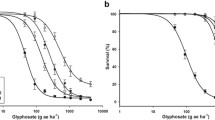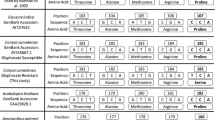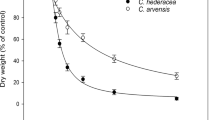Abstract
Main conclusion
Field-evolved resistance of goosegrass to glyphosate is due to double or single mutation in EPSPS , or amplification of EPSPS leads to increased transcription and protein levels.
Glyphosate has been used widely in the south of China. The high selection pressure from glyphosate use has led to the evolution of resistance to glyphosate in weeds. We investigated the molecular mechanisms of three recently discovered glyphosate-resistant Eleusine indica populations (R1, R2 and R3). The results showed that R1 and R2 had double Thr102Ile and Pro106Ser mutation and a single mutation of Pro106Leu in the 5-enolpyruvylshikimate-3-phosphate synthase (EPSPS) gene, respectively. Escherichia coli containing the mutated EPSPS genes was tolerant to glyphosate. EPSPS activity in R1 and R2 plants was higher than in the sensitive plants. There was no amino acid substitution in EPSPS gene in R3. However, expression of EPSPS in R3 plants was higher than in glyphosate-susceptible (S) population (13.8-fold) after glyphosate treatment. EPSPS enzyme activity in both R3 and S plants was inhibited by glyphosate, while shikimate accumulation in R3 was significantly lower than for the S population. Further analysis revealed that the genome of R3 contained 28.3-fold more copies of the EPSPS gene than that of susceptible population. EPSPS expression was positively correlated with copy number of EPSPS. In conclusion, mutation of the EPSPS gene and increased EPSPS expression are part of the molecular mechanisms of resistance to glyphosate in Eleusine indica.







Similar content being viewed by others
Abbreviations
- EPSPS:
-
5-enolpyruvylshikimate-3-phosphate synthase
- GR:
-
Glyphosate-resistant
- S:
-
Glyphosate-susceptible
- PCR:
-
Polymerase chain reaction
References
Alarcón-Reverte R, García A, Urzúa J, Fischer AJ (2013) Resistance to glyphosate in junglerice (Echinochloa colona) from California. Weed Sci 61(1):48–54
Baerson SR, Rodriguez DJ, Tran M, Feng Y, Biest NA, Dill GM (2002) Glyphosate-resistant goosegrass. Identification of a mutation in the target enzyme 5-enolpyruvylshikimate-3-phosphate synthase. Plant Physiol 129(3):1265–1275
Bell MS, Hager AG, Tranel PJ (2013) Multiple resistance to herbicides from four site-of-action groups in waterhemp (Amaranthus tuberculatus). Weed Sci 61(3):460–468
Bostamam Y, Malone JM, Dolman FC, Boutsalis P, Preston C (2012) Rigid ryegrass (Lolium rigidum) populations containing a target site mutation in EPSPS and reduced glyphosate translocation are more resistant to glyphosate. Weed Sci 60(3):474–479
Bustin SA, Benes V, Garson JA, Hellemans J, Huggett J, Kubista M, Mueller R, Nolan T, Pfaffl MW, Shipley GL (2009) The MIQE guidelines: minimum information for publication of quantitative real-time PCR experiments. Clin Chem 55(4):611–622
Collavo A, Sattin M (2012) Resistance to glyphosate in Lolium rigidum selected in Italian perennial crops: bioevaluation, management and molecular bases of target-site resistance. Weed Res 52(1):16–24
de Carvalho LB, Alves PLCA, González-Torralva F, Cruz-Hipolito HE, Rojano-Delgado AM, De Prado R, Gil-Humanes J, Barro F, Luque deCastro MD (2012) Pool of resistance mechanisms to glyphosate in Digitaria insularis. J Agri Food Chem 60(2):615–622
Funke T, Yang Y, Han H, Healy-Fried M, Olesen S, Becker A, Schönbrunn E (2009) Structural basis of glyphosate resistance resulting from the double mutation Thr97 → Ile and Pro101 → Ser in 5-enolpyruvylshikimate-3-phosphate synthase from Escherichia coli. J Biolog Chem 284(15):9854–9860
Gaines TA, Zhang W, Wang D, Bukun B, Chisholm ST, Shaner DL, Nissen SJ, Patzoldt WL, Tranel PJ, Culpepper AS (2010) Gene amplification confers glyphosate resistance in Amaranthus palmeri. Proc Nat Acad Sci 107(3):1029–1034
Gaines TA, Shaner DL, Ward SM, Leach JE, Preston C, Westra P (2011) Mechanism of resistance of evolved glyphosate-resistant Palmer amaranth (Amaranthus palmeri). J Agri Food Chem 59(11):5886–5889
Gaitonde M, Gordon MW (1958) Amicrochemical method for the detection and determination of shikimic acid. J Biol Chem 230(2):1043–1050
Ganeshaiah K, Shaanker RU (1982) Evolution of reproductive behaviour in the genus eleusine. Euphytica 31(2):397–404
Ge X, d’Avignon DA, Ackerman JJ, Sammons RD (2010) Rapid vacuolar sequestration: the horseweed glyphosate resistance mechanism. Pest Manag Sci 66(4):345–348
Ge X, d’Avignon DA, Ackerman JJ, Collavo A, Sattin M, Ostrander EL, Hall EL, Sammons RD, Preston C (2012) Vacuolar glyphosate-sequestration correlates with glyphosate resistance in ryegrass (Lolium spp.) from Australia, south America, and Europe: a 31P NMR investigation. J Agri Food Chem 60(5):1243–1250
González-Torralva F, Gil-Humanes J, Barro F, Brants I, De Prado R (2012) Target site mutation and reduced translocation are present in a glyphosate-resistant Lolium multiflorum Lam. biotype from Spain. J Agri Food Chem 58:16–22
Healy-Fried ML, Funke T, Priestman MA, Han H, Schönbrunn E (2007) Structural basis of glyphosate tolerance resulting from mutations of Pro101 in Escherichia coli 5-enolpyruvylshikimate-3-phosphate synthase. J Biol Chem 282(45):32949–32955
Heap I (2015) The international survey of herbicide resistant weeds. www.weedscience.org. Accessed 15 Mar 2015
Howe AR, Gasser CS, Brown SM, Padgette SR, Hart J, Parker GB (2002) Glyphosate as a selective agent for the production of fertile transgenic maize (Zea mays L.) plants. Mol Breed 10:153–164
Jasieniuk M, Ahmad R, Sherwood AM, Firestone JL, Perez-Jones A, Lanini WT, Mallory-Smith C, Stednick Z (2008) Glyphosate-resistant Italian ryegrass (Lolium multiflorum) in California: distribution, response to glyphosate, and molecular evidence for an altered target enzyme. Weed Sci 56(4):496–502
Jingchao C, Hongjuan H, Shouhui W, Chaoxian Z, Hongjuan H (2015) Characterization of glyphosate-resistant goosegrass (Eleusine indica) populations in China. J Int Agri 14(5):919–925
Kahrizi D, Salmanian AH, Afshari A, Moieni A, Mousavi A (2007) Simultaneous substitution of Gly96 to Ala and Ala183 to Thr in 5-enolpyruvylshikimate-3-phosphate synthase gene of E. coli (k12) and transformation of rapeseed (Brassica napus L.) in order to make tolerance to glyphosate. Plant Cell Rep 26:95–104
Kaundun SS, Zelaya IA, Dale RP, Lycett AJ, Carter P, Sharples KR, McIndoe E (2008) Importance of the P106S target-site mutation in conferring resistance to glyphosate in a goosegrass (Eleusine indica) population from the Philippines. Weed Sci 56(5):637–646
Kaundun SS, Dale RP, Zelaya IA, Dinelli G, Marotti I, McIndoe E, Cairns A (2011) A novel P106L mutation in EPSPS and an unknown mechanism (s) act additively to confer resistance to glyphosate in a south African Lolium rigidum population. J Agric Food Chem 59(7):3227–3233
Lebrun M, Sailland A, Freyssinet G and Degryse E (2003) Mutated 5-enolpyruvylshikimate-3-phosphate synthase, gene coding for said protein and transformed plants containing said gene. US 6,566,587, Bayer CropScience SA, pp 1–17
Lee LJ, Ngim J (2000) A first report of glyphosate-resistant goosegrass (Eleusine indica (L) Gaertn) in Malaysia. Pest Manag Sci 56(4):336–339
Lorentz L, Gaines TA, Nissen SJ, Westra P, Strek HJ, Dehne HW, Ruiz-Santaella JP, Beffa R (2014) Characterization of glyphosate resistance in Amaranthus tuberculatus populations. J Agric Food Chem 62(32):8134–8142
Mueller TC, Barnett KA, Brosnan JT, Steckel LE (2011) Glyphosate-Resistant Goosegrass (Eleusine indica) Confirmed in Tennessee. Weed Sci 59(4):562–566
Nandula V, Ray JD, Ribeiro D, Pan Z, Reddy K (2013) Glyphosate resistance in Tall Waterhemp (Amaranthus tuberculatus) from Mississippi is due to both altered target site and non-target site mechanisms. Weed Sci 61(3):374–383
Nandula VK, Wright AA, Bond JA, Ray JD, Eubank TW, Molin WT (2014) EPSPS amplification in glyphosate-resistant spiny amaranth (Amaranthus spinosus): a case of gene transfer via interspecific hybridization from glyphosate-resistant Palmer amaranth (Amaranthus palmeri). Pest Manag Sci 70(12):1902–1909
Ng C, Wickneswari R, Salmijah S, Teng Y, Ismail B (2003) Gene polymorphisms in glyphosate-resistant and-susceptible biotypes of Eleusine indica from Malaysia. Weed Res 43(2):108–115
Perez-Jones A, Park K-W, Polge N, Colquhoun J, Mallory-Smith CA (2007) Investigating the mechanisms of glyphosate resistance in Lolium multiflorum. Planta 226(2):395–404
Pfaffl MW, Tichopad A, Prgomet Christian, Neuvians TP (2004) Determination of stable housekeeping genes, differentially regulated target genes and sample integrity: BestKeeper-Excel-based tool using pair-wise correlations. Biotechnol Lett 26:509–515
Powles SB (2008) Evolved glyphosate-resistant weeds around the world: lessons to be learnt. Pest Manag Sci 64(4):360–365
Pratley J, Urwin N, Stanton R, Baines P, Broster J, Cullis K, Schafer D, Bohn J, Krueger R (1999) Resistance to glyphosate in Lolium rigidum. I. Bioevaluation. Weed Sci 47:405–411
Preston C, Wakelin AM (2008) Resistance to glyphosate from altered herbicide translocation patterns. Pest Manag Sci 64(4):372–376
Salas RA, Dayan FE, Pan Z, Watson SB, Dickson JW, Scott RC, Burgos NR (2012) EPSPS gene amplification in glyphosate-resistant Italian ryegrass (Lolium perenne ssp. multiflorum) from Arkansas. Pest Manag Sci 68(9):1223–1230
Sammons RD, Gaines TA (2014) Glyphosate resistance: state of knowledge. Pest Manag Sci 70(9):1367–1377
Seefeldt S, Jensen J, Fuerst E (1995) Log-logistic analysis of herbicide dose-response relationship. Weed Technol 9:218–227
Shaner DL (2009) Role of translocation as a mechanism of resistance to glyphosate. Weed Sci 57(1):118–123
Simarmata M, Penner D (2008) The basis for glyphosate resistance in rigid ryegrass (Lolium rigidum) from California. Weed Sci 56(2):181–188
Steinrücken H, Amrhein N (1980) The herbicide glyphosate is a potent inhibitor of 5-enolpyruvylshikimic acid-3-phosphate synthase. Biochem Biophy Res Comm 94(4):1207–1212
Vargas L, Ulguim A, Agostinetto D, Magro T, Thürmer L (2013) Low level resistance of goosegrass (Eleusine indica) to glyphosate in Rio Grande do Sul-Brazil. Planta Daninha 31(3):677–686
Wakelin AM, Preston C (2006) A target-site mutation is present in a glyphosate-resistant Lolium rigidum population. Weed Res 46(5):432–440
Wiersma AT, Gaines TA, Preston C, Hamilton JP, Giacomini D, Buell CR, Leach JE, Westra P (2014) Gene amplification of 5-enol-pyruvylshikimate-3-phosphate synthase in glyphosate-resistant Kochia scoparia. Planta. doi:10.1007/s00425-014-2197-9
Woodburn AT (2000) Glyphosate: production, pricing and use worldwide. Pest Manag Sci 56(4):309–312
Yang CH, Tian XS, Feng L, Yue MF (2012) Resistance of Eleusine indica Gaertn to glyphosate. Scientia Agricultura Sinica 45(10):2093–2098
Yu Q, Cairns A, Powles S (2007) Glyphosate, paraquat and ACCase multiple herbicide resistance evolved in a Lolium rigidum biotype. Planta 225(2):499–513
Yu Q, Jalaudin A, Han HP, Chen M, Sammons RD, Powles SB (2015) Evolution of a double amino acid substitution in the EPSP synthase in Eleusine indica conferring high level glyphosate resistance. Plant Physiol. doi:10.1104/pp.15.00146
Acknowledgments
This research was funded by Special Fund for Agro-scientific Research in the Public Interest (201303022). The authors thank the anonymous reviewers for improving the language of the manuscript.
Conflict of interest
The authors declare that they have no conflict of interest.
Ethical approval
This article does not contain any studies with human participants performed by any of the authors.
Informed consent
Informed consent was obtained from all individual participants included in the study.
Author information
Authors and Affiliations
Corresponding author
Rights and permissions
About this article
Cite this article
Chen, J., Huang, H., Zhang, C. et al. Mutations and amplification of EPSPS gene confer resistance to glyphosate in goosegrass (Eleusine indica). Planta 242, 859–868 (2015). https://doi.org/10.1007/s00425-015-2324-2
Received:
Accepted:
Published:
Issue Date:
DOI: https://doi.org/10.1007/s00425-015-2324-2




